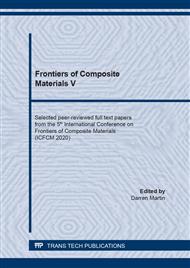[1]
F. Sheikh Khalid, H. Shah Herman, N. B. Azmi, and M. I. Juki, Sand Cement Brick Containing Recycled Concrete Aggregate as Fine-Aggregate Replacement,, in MATEC Web of Conferences, (2017).
DOI: 10.1051/matecconf/201710301016
Google Scholar
[2]
I. O. Agbede and M. Joel, Use of cement-sand admixture in laterite brick production for low cost housing,, Leonardo Electron. J. Pract. Technol., (2008).
Google Scholar
[3]
A. A. Wahab, M. F. Arshad, Z. Ahmad, A. R. Mohd Ridzuan, and M. H. Wan Ibrahim, Potential of bottom ash as sand replacement material to produce sand cement brick,, Int. J. Integr. Eng., (2018).
Google Scholar
[4]
C. Sukesh, K. Bala Krishna, Ps. Lakshmi Sai Teja, and Sk. Rao, Partial Replacement of Sand with Quarry Dust in Concrete,, Int. J. Innov. Technol. Explor. Eng., (2013).
Google Scholar
[5]
V. Nozahic and S. Amziane, Influence of sunflower aggregates surface treatments on physical properties and adhesion with a mineral binder,, Compos. Part A Appl. Sci. Manuf., (2012).
DOI: 10.1016/j.compositesa.2012.07.011
Google Scholar
[6]
L. T. T. Vo and P. Navard, Treatments of plant biomass for cementitious building materials – A review,, Construction and Building Materials. (2016).
DOI: 10.1016/j.conbuildmat.2016.05.125
Google Scholar
[7]
A. Amiri, Z. Triplett, A. Moreira, N. Brezinka, M. Alcock, and C. A. Ulven, Standard density measurement method development for flax fiber,, Ind. Crops Prod., (2017).
DOI: 10.1016/j.indcrop.2016.11.060
Google Scholar
[8]
S. R. Karade, Cement-bonded composites from lignocellulosic wastes,, Construction and Building Materials. (2010).
DOI: 10.1016/j.conbuildmat.2010.02.003
Google Scholar
[9]
Information on, http://www.lktn.gov.my, Accessed on 11th May (2015).
Google Scholar
[10]
M. R. Ishak, Z. Leman, S. M. Sapuan, A. M. M. Edeerozey, and I. S. Othman, Mechanical properties of kenaf bast and core fibre reinforced unsaturated polyester composites,, IOP Conf. Ser. Mater. Sci. Eng., (2010).
DOI: 10.1088/1757-899x/11/1/012006
Google Scholar
[11]
A. Elsaid, M. Dawood, R. Seracino, and C. Bobko, Mechanical properties of kenaf fiber reinforced concrete,, Constr. Build. Mater., (2011).
DOI: 10.1016/j.conbuildmat.2010.11.052
Google Scholar
[12]
G. Siti Aisyah, S. Zul Hilmi, A. H. Nabilah Huda, M. T. Ramlah, M. J. Janmaizatulriah, and S. A. Sharifah Aminah, Comparative Debark and Macronutrients Content from Retting Water Using 1:2 and 1:10 Kenaf Weight to Water Volume Ratio,, in InCIEC 2015, (2016).
DOI: 10.1007/978-981-10-0155-0_4
Google Scholar
[13]
B. Choi, J. Y. Chung, H. J. Bae, I. Bae, S. Park, and H. Bae, Functional characterization of cinnamyl alcohol dehydrogenase during developmental stages and under various stress conditions in kenaf (Hibiscus cannabinus L.),, BioResources, (2016).
DOI: 10.15376/biores.11.1.105-125
Google Scholar
[14]
A. Almusawi, R. Lachat, K. E. Atcholi, and S. Gomes, Proposal of manufacturing and characterization test of binderless hemp shive composite,, Int. Biodeterior. Biodegrad., (2016).
DOI: 10.1016/j.ibiod.2016.09.011
Google Scholar
[15]
Y. Kojima, Kenaf as a Bioresource for Production of Hydrogen-rich Gas,, Agrotechnology, vol. 03, no. 01, p.1–8, (2014).
DOI: 10.4172/2168-9881.1000125
Google Scholar
[16]
A. Nor Munirah, M. T. Ramlah, and A. Sharifah, Cellulosic Materials Characterisation of Kenaf Core from Retting Process Using Thermal Analysis,, Appl. Mech. Mater., (2015).
DOI: 10.4028/www.scientific.net/amm.754-755.1023
Google Scholar
[17]
Z. M. Salisu, S. U. Ishiaku, D. Abdullahi, M. K. Yakubu, and B. H. Diya'uddeen, Development of kenaf shive bio–mop via surface deposit technique for water remediation from crude oil spill contamination,, Results Eng., (2019).
DOI: 10.1016/j.rineng.2019.100020
Google Scholar
[18]
E. Aamr-Daya, T. Langlet, A. Benazzouk, and M. Quéneudec, Feasibility study of lightweight cement composite containing flax by-product particles: Physico-mechanical properties,, Cem. Concr. Compos., (2008).
DOI: 10.1016/j.cemconcomp.2008.06.002
Google Scholar
[19]
J. Cigasova, N. Stevulova, I. Schwarzova, A. Sicakova, and J. Junak, Application of hemp hurds in the preparation of biocomposites,, in IOP Conference Series: Materials Science and Engineering, (2015).
DOI: 10.1088/1757-899x/96/1/012023
Google Scholar
[20]
Y. Diquélou, E. Gourlay, L. Arnaud, and B. Kurek, Impact of hemp shiv on cement setting and hardening: Influence of the extracted components from the aggregates and study of the interfaces with the inorganic matrix,, Cem. Concr. Compos., (2015).
DOI: 10.1016/j.cemconcomp.2014.09.004
Google Scholar
[21]
S. Mohamad Jani and K. Izran, Kenaf core particleboard and its sound absorbing properties,, J. Sci. Technol., (2012).
Google Scholar
[22]
H. A. Aisyah, M. T. Paridah, M. H. Sahri, U. M. K. Anwar, and A. A. Astimar, Properties of medium density fibreboard (MDF) from kenaf (Hibiscus cannabinus L.) core as function of refining conditions,, Compos. Part B Eng., (2013).
DOI: 10.1016/j.compositesb.2012.02.029
Google Scholar
[23]
T. Poonsawat, P. Ritdet, and S. Jarusombutti, Value-added products from kenaf and hemp core residue,, J. Eng. Appl. Sci., (2016).
Google Scholar
[24]
BS-EN197-1:, Cement Part 1: Composition, Specifications and Conformity Criteria for Common Cements,, Br. Stand., (2011).
Google Scholar
[25]
Jabatan Kerja Raya Malaysia, JKR 20800-0183-14 (2014): Standard Specifications for Building Works,.
Google Scholar
[26]
BS-EN771-3:2011;, BSI Standards Publication Specification for masonry units Part 3 : Aggregate concrete masonry units ( Dense and lightweight aggregates ),, BSI Stand. Publ., (2011).
DOI: 10.3403/03006778u
Google Scholar
[27]
BS EN 772-1, BSI Standards Publication Methods of test for masonry units Part 1 : Determination of compressive strength,, BSI Stand. Publ., 201.
Google Scholar
[28]
BS EN 772-13, BSI Standards Publication Methods of Test for Masonry Units–Part 13: Determination of Net and Gross Dry Density of Masonry Units (Except for Natural Stone),, Czech Repub., (2001).
DOI: 10.3403/01784881
Google Scholar
[29]
L.W. Charles, K. B. Venita, and E. B. Robert in: Trends in new crops and new uses, edtied by J. Janick and A. Whipkey/ ASHS Press, Alexandria, VA (2002).
Google Scholar
[30]
C. L. Hwang and T. P. Huynh, Investigation into the use of unground rice husk ash to produce eco-friendly construction bricks,, Constr. Build. Mater., (2015).
DOI: 10.1016/j.conbuildmat.2015.04.061
Google Scholar


